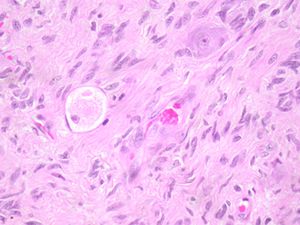Key-Gaskell Syndrome
- Autonomic polyganglioneuropathy in cats
- Abnormal function of the sympathetic and parasympathetic system.
- Whole autonomic system involved – affected animals usually die.
- Similar to grass sickness in horses.
Clinical
- Cats show:
- Megaoesophagus
- Dilated pupils
- Whole gut is involved (very little peristalsis)
- Constipation.
- Generalised autonomic effects:
- Reduced salivation
- Reduced lachrymation
- Bradycardia
- Constipation
- Pupillary dilatation
Pathology
- Histologically there is marked reduction in the number of neurones in all autonomic ganglia in the ventral horn of all levels of spinal cord accompanied by proliferation of non-neuronal cells.
- Similar changes in brain stem nuclei of cranial nerves.
Pathogenesis
- Acquired disease - outbreaks occurred in the past, now only occasionally seen but seems to be getting more common again.
- Possibly toxic cause.
- Possibly in dry food or in vaccine?
- Agent not really known, but produces general damage to autonomic nervous system.
Feline dysautonomia, or Key-Gaskell Syndrome
- Occurs mostly in the UK and continental Europe.
- Is also of unknown aetiology. Suggested causative factors include:
- Environmental toxins
- Infectious agents
- Botulinum toxins .
- Clinical signs:
- Anorexia
- Depression
- Bradycardia
- Decreased lacrimation,
- Altered pupillary dilataion,
- Megaoesophagus
- Constipation.
- Degenerative lesions of autonomic nerve ganglia can be seen.
- Also occurs in the oesophagus.
Also known as Feline Key-Gaskell Syndrome and Feline Autonomic Polygangliopathy.
Part of a syndrome of generalised autonomic neuropathy. It has been observed throughout Western Europe and The United States.
Signalment
- Historically reported most frequently in cats but now also in dogs
- Usually seen in younger dogs
- No sex predisposition
- In a recent study of 65 dogs confirmed as having dysautonomia those raised and housed in rural environments appeared to be at greater risk (56/65 dogs) for dysautonomia than dogs from the city
- Labrador Retrievers may have a breed predisposition
Description
- Degenerative lesions of the autonomic ganglia, spinal cord intermediate grey columns and sympathetic axons
- Aetiology still largely idiopathic
Diagnosis
Clinical Signs
Those of a generalised autonomic dysfuntion of the gastrointestinal and urinary tracts. Those associated with the oesophagus include:
- Regurgitation
- Megaoesophagus
- Oesophageal hypotmotility
The most frequent clinical signs associated with the syndrome are depression, anorexia, constipation and regurgitation or vomiting. Incontinence (faecal and urinary) has been observed less frequently.
Physical Examination
Findings associated with the GI system include:
- Dry mucous membranes
- Intestinal distension
Radiography
Plain Radiography
Oesophageal dilatation may be observed.
Contrast Radiography
Oesophageal hypomotility may be evident on barium contrast study.
Histological Findings
Chromatolytic degeneration in autonomic ganglia, spinal cord intermediate grey columns and some sympathetic axons.
Pharmalogical Testing
- Topical ocular administration of dilute pilocarpine - miosis implies a postive result. However, not all respond. Response is dependent on damage to the postganglionic parasympathetic neuron causing supersensitivity of the iris muscle
- IV or SC administration of atropine (a parasympatholytic) - lack of increase in heart rate implies a positive result
- ID administration of histamine - the wheal and flare response may be dampened in those with dysautonomia
Differential Diagnosis
There are few differentials on presentation of the many manifestations of the disease. However, early in the course of disease other causes of megaoesophagus need to be considered.
Treatment
Supportive
Including elevated feeding, gastrostomy tube feedings or total paranteral nutrition.
Parasympathomimetic Drugs
Some dogs may show minor improvement on initiation of for example, bethanechol, metoclopramide.
Prognosis
Guarded to poor. Recovery rates in the cat are reported as 20-40%, however this may take 2-12 months. In the dog recovery rates are lower. Despite recovery many are also left with residual impairment including intermittent regurgitation.
References
- Hall J.H, Wimpson J. W. and Williams D.A, (2005), Disorders of the Pharynx and Oesophagus, in BSAVA Manual of Canine and Feline Gastroenterology, 2nd Edition, British Small Animal Association, Gloucester, pp 142-143
- Harkin K.R, Andrews G.A, Nietfeld J.C, (2002), Dysautonomia in dogs: 65 cases (1993–2000) J Am Vet Med Assoc, Mar 1, 220(5): pp. 633-9
